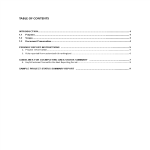Project Progress Report
Save, fill-In The Blanks, Print, Done!

Download Project Progress Report
Adobe Acrobat (.pdf)- This Document Has Been Certified by a Professional
- 100% customizable
- This is a digital download (320.88 kB)
- Language: English
- We recommend downloading this file onto your computer.
How to make a professional Project Progress Report? Is it important to keep track of progress on a project? Get this sample template now which is designed to help you monitor and measure the progress of a project. It can be also used to identify and address any potential issues before they become serious. Download this report template now!
A project progress report is a document that provides a comprehensive overview of the status, achievements, challenges, and other relevant information about a specific project. It is typically prepared and shared on a regular basis, such as weekly, monthly, or quarterly, to keep stakeholders informed about the project's development and to ensure that it is on track to meet its goals and objectives. Project progress reports are used in various industries and settings, including business, construction, government, nonprofit organizations, and more.
The key elements typically included in a project progress report are as follows:
- Project Information: This section includes basic details about the project, such as the project name, ID or reference number, the name of the project manager, and the reporting period (e.g., the reporting date or period covered by the report).
- Executive Summary: A concise summary that provides an overview of the project's current status, major achievements, challenges, and upcoming milestones. This section is often used to give a quick snapshot of the project's progress.
- Objective and Scope: A description of the project's goals, objectives, and scope to remind stakeholders of the project's purpose and focus.
- Key Performance Indicators (KPIs): A presentation of relevant KPIs and metrics, such as timelines, budgets, quality indicators, and any other measures that help assess the project's performance.
- Progress and Achievements: A detailed account of what has been accomplished during the reporting period. This can include completed tasks, milestones achieved, and significant progress made.
- Challenges and Issues: A discussion of any problems, obstacles, or challenges that the project has encountered, along with potential solutions or actions taken to address them.
- Work Plan and Schedule: An update on the project's schedule, including an overview of upcoming activities and milestones. This section often compares the planned schedule to the actual progress.
- Resource Allocation: Information about the allocation of resources, including budget, personnel, and any changes made in resource allocation during the reporting period.
- Risks and Mitigation Strategies: An overview of identified risks and the strategies in place to mitigate or manage them.
- Budget and Expenditures: A summary of the project's financial status, including the budget, actual expenditures, and any significant budget variances.
- Recommendations: Suggestions or recommendations for actions that should be taken based on the current project status.
- Conclusion: A summary of the key points presented in the report and an overall assessment of the project's progress.
- Appendix: Any additional documents or data that support the information presented in the report, such as charts, graphs, or detailed project plans.
Project progress reports are crucial for effective project management and communication with stakeholders, including project sponsors, team members, clients, and regulatory authorities. They help in tracking progress, identifying issues early, making informed decisions, and ensuring that the project stays on track to meet its objectives. The frequency and level of detail in these reports can vary depending on the project's complexity, size, and the needs of the stakeholders.
Download this project progress report template now!
DISCLAIMER
Nothing on this site shall be considered legal advice and no attorney-client relationship is established.
Leave a Reply. If you have any questions or remarks, feel free to post them below.
Related templates
Latest templates
Latest topics
- Excel Templates
Where do I find templates for Excel? How do I create a template in Excel? Check these editable and printable Excel Templates and download them directly! - GDPR Compliance Templates
What do you need to become GDPR compliant? Are you looking for useful GDPR document templates to make you compliant? All these compliance documents will be available to download instantly... - Google Docs Templates
How to create documents in Google Docs? We provide Google Docs compatible template and these are the reasons why it's useful to work with Google Docs... - IT Security Standards Kit
What are IT Security Standards? Check out our collection of this newly updated IT Security Kit Standard templates, including policies, controls, processes, checklists, procedures and other documents. - Letter Format
How to format a letter? Here is a brief overview of common letter formats and templates in USA and UK and get inspirited immediately!
cheese



